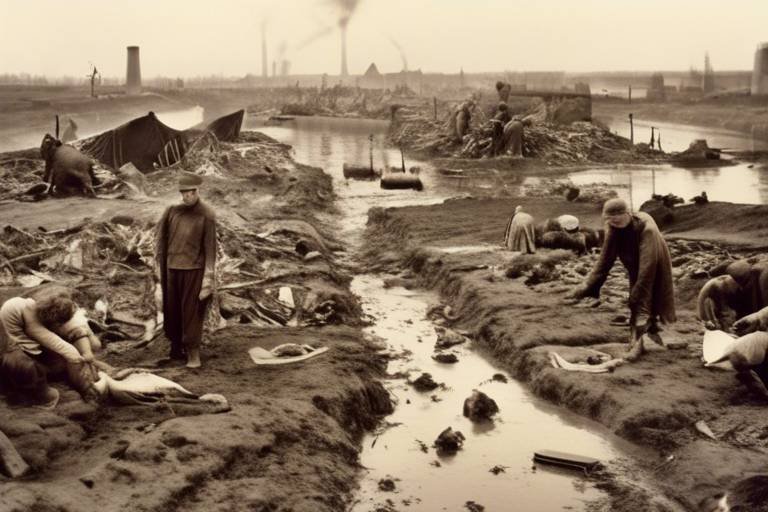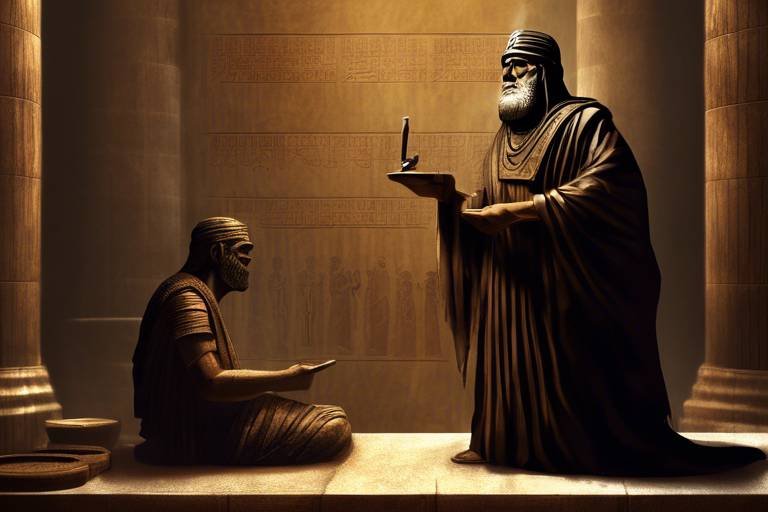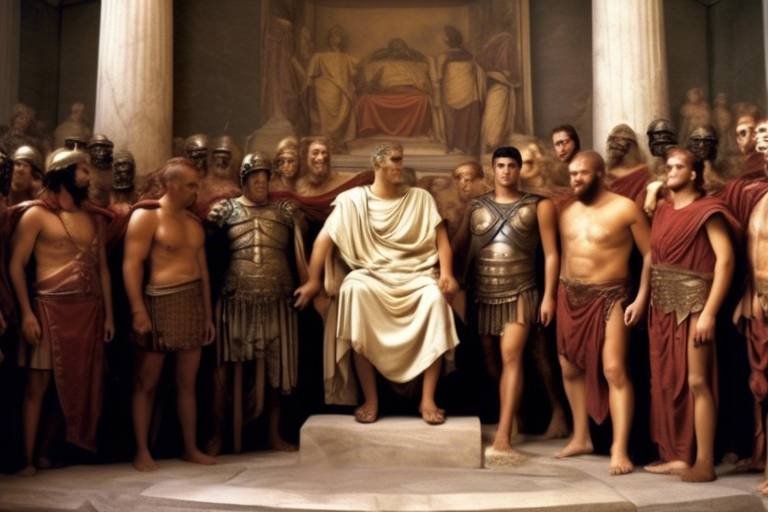The Legacy of Ancient Rome - Architecture and Engineering
When we delve into the legacy of ancient Rome, we uncover a treasure trove of architectural and engineering marvels that have stood the test of time and continue to influence modern structures worldwide. The ingenuity and vision of Roman builders have left an indelible mark on the world, showcasing a blend of innovation, aesthetics, and functionality that transcends centuries.
The architectural wonders of ancient Rome, from the majestic Colosseum to the awe-inspiring Pantheon, stand as testaments to the grandeur and sophistication of Roman design. These iconic structures not only captivate with their sheer size and beauty but also reveal the advanced engineering principles that underpin their construction.
One of the key contributions of Roman engineering lies in their innovative techniques, such as the mastery of arches, vaults, and the groundbreaking use of concrete. These techniques revolutionized construction practices of the time and laid the foundation for many architectural advancements that followed.
Among the most impressive achievements of Roman engineering are the elaborate aqueducts that served as vital arteries for supplying water to bustling cities. The intricate network of aqueducts exemplifies the engineering prowess and strategic planning that characterized Roman infrastructure projects.
Urban planning was another area where the Romans excelled, with meticulous attention to detail evident in the layout of their cities. From the organization of streets and public spaces to the construction of baths and forums, Roman urban planning aimed to create efficient, beautiful, and socially cohesive communities.
Roman temples, with their imposing facades and intricate designs, symbolized the fusion of architectural brilliance and religious significance. These iconic structures not only served as places of worship but also influenced the development of religious and civic architecture for generations to come.
The legacy of ancient Roman architecture extends far beyond the borders of the ancient empire, shaping the landscape of modern buildings and structures. From neoclassical revivals that pay homage to Roman design principles to contemporary interpretations that reinvent ancient techniques, the influence of Roman architecture remains palpable in the world of construction.
Modern construction practices continue to be influenced by the innovations of Roman engineers, from the emphasis on structural stability to the choice of durable materials. The enduring legacy of Roman engineering can be seen in the evolution of architectural design and the quest for sustainable building practices.
As we reflect on the enduring legacy of ancient Rome, we are reminded of the timeless wisdom embedded in their construction methods and materials. The sustainable aspects of Roman architecture have contributed to the longevity and endurance of ancient structures, offering valuable lessons for architects and builders striving to create sustainable and resilient buildings today.

Roman Architectural Marvels
When it comes to Roman architectural marvels, one cannot help but be awestruck by the grandeur and innovation displayed in structures like the Colosseum, Pantheon, and aqueducts. These iconic landmarks not only stand as testaments to the architectural prowess of the Romans but also serve as timeless reminders of their engineering ingenuity.
The Colosseum, with its massive amphitheater design capable of seating tens of thousands of spectators, showcases the Romans' mastery of architectural scale and functionality. Its innovative use of arches and vaults not only provided structural support but also created a visually stunning spectacle that continues to captivate visitors to this day.
Similarly, the Pantheon's iconic dome, with its oculus allowing natural light to filter into the interior, represents a groundbreaking architectural achievement that remains unmatched in its elegance and engineering complexity. The precision and symmetry of its design reflect the Romans' meticulous attention to detail and geometric harmony.
Furthermore, the Roman aqueducts stand as remarkable feats of engineering, showcasing the sophisticated water management system that supplied cities with fresh water. The intricate network of channels, bridges, and reservoirs not only demonstrated the Romans' mastery of hydraulic engineering but also highlighted their commitment to urban infrastructure and public health.

Innovative Engineering Techniques
When it comes to innovative engineering techniques, the ancient Romans were true pioneers in the field of construction. One of their most notable contributions was the development and widespread use of arches. These semi-circular structures not only provided exceptional strength and stability but also allowed for the creation of vast open spaces such as the iconic Roman aqueducts and amphitheaters.
Furthermore, the Romans mastered the art of vaulted ceilings, which enabled them to construct large, expansive buildings with soaring heights. The Pantheon, with its magnificent dome, stands as a testament to their expertise in utilizing this technique to achieve architectural grandeur.
Another groundbreaking innovation was the use of concrete as a primary building material. The Romans formulated a durable and versatile concrete mixture that could be molded into various shapes, revolutionizing construction practices. This invention laid the foundation for the development of modern concrete structures that we see today.
Moreover, the Romans excelled in the construction of complex road systems that connected their vast empire. Their expertise in surveying and leveling the terrain allowed for the creation of efficient and durable roads that facilitated trade, communication, and military movement.
Overall, the innovative engineering techniques employed by the ancient Romans not only revolutionized construction practices of their time but also laid the groundwork for many architectural advancements that continue to influence modern building design.

Aqueducts and Water Management
Exploring the enduring impact of Roman architectural and engineering achievements on modern structures and infrastructure worldwide, showcasing the innovative techniques and iconic designs that continue to inspire contemporary builders.
Delving into the grandeur of Roman architectural feats such as the Colosseum, Pantheon, and aqueducts, highlighting the advanced engineering principles and enduring beauty that define these structures.
Examining the innovative engineering techniques employed by the Romans, including arches, vaults, and concrete, and their revolutionary impact on construction practices still in use today.
Aqueducts played a vital role in Roman society, showcasing remarkable engineering prowess and strategic planning. These impressive structures were designed to transport water from distant sources to urban centers, ensuring a stable water supply for public baths, fountains, and private residences. The intricate network of aqueducts demonstrated the Romans' mastery of hydraulic engineering, utilizing gravity to deliver water efficiently over long distances. The meticulous planning and construction of aqueducts reflect the Romans' commitment to urban development and public health, setting a precedent for future water management systems.
Discussing the meticulous urban planning of Roman cities, focusing on the layout, infrastructure, and public spaces designed for efficiency, beauty, and social cohesion.
Highlighting the architectural brilliance of Roman temples, examining their distinctive features, symbolism, and enduring influence on religious and civic architecture.
Tracing the influence of Roman architecture on contemporary buildings, from neoclassical revivals to modern interpretations that continue to draw inspiration from ancient Roman design principles.
Exploring how Roman engineering innovations have shaped modern construction practices, from structural stability to material choices, contributing to the evolution of architectural design.
Analyzing the sustainable aspects of Roman construction methods and materials that have contributed to the longevity and endurance of ancient structures, providing valuable lessons for sustainable building practices today.
Stay tuned for the frequently asked questions section, where we address common queries related to the legacy of ancient Roman architecture and engineering.

Roman Urban Planning
When it comes to Roman urban planning, one cannot help but marvel at the meticulous attention to detail and foresight displayed in the layout of cities. The Romans were not just builders; they were master urban planners, creating cities that were not only functional but also beautiful and efficient.
One of the key features of Roman urban planning was the division of cities into distinct regions, each serving a specific purpose. From residential areas to commercial districts and public spaces, every part of the city was carefully organized to promote order and harmony.
Furthermore, Roman cities were designed with a focus on infrastructure, ensuring easy access to essential services such as water supply, sanitation, and transportation. The construction of well-planned roads, bridges, and aqueducts facilitated the movement of people and goods, contributing to the prosperity of urban centers.
The Romans also incorporated elements of social cohesion into their urban planning, creating communal spaces such as forums, amphitheaters, and baths where residents could gather, socialize, and engage in cultural activities. These public spaces not only served as centers of civic life but also reinforced a sense of community among the inhabitants.
Moreover, Roman urban planning embraced the concept of aesthetics, with an emphasis on creating visually appealing cities adorned with statues, fountains, and ornate buildings. The architectural beauty of Roman cities was not just a matter of luxury but a reflection of the Romans' appreciation for art and culture.
In essence, Roman urban planning was a harmonious blend of functionality, beauty, and social organization, setting a benchmark for future city planning endeavors. The legacy of Roman urban design continues to influence modern urban development, reminding us of the enduring relevance of ancient architectural and planning principles.

Iconic Roman Temples
When it comes to , one cannot help but marvel at the architectural brilliance and symbolic significance embedded in these ancient structures. The Roman temples stand as a testament to the ingenuity and spiritual devotion of the Roman civilization, showcasing a harmonious blend of artistry and engineering prowess.
One of the most famous Roman temples is the Pantheon, renowned for its magnificent dome and innovative design that continues to inspire architects to this day. The Pantheon's oculus, or open central space, allows natural light to filter in, creating a celestial effect that enhances the spiritual experience within the temple.
Another iconic Roman temple is the Temple of Saturn, dedicated to the god of agriculture and wealth. This majestic structure features impressive columns and intricate friezes that depict mythological scenes, serving as a visual narrative of Roman beliefs and values.
Symbolism played a crucial role in the design of Roman temples, with each architectural element carrying deeper meanings and religious significance. The Temple of Vesta, for example, symbolized the eternal flame of the hearth and served as a sacred space for the Roman goddess of the home and family.
The Temple of Jupiter Optimus Maximus, located on the Capitoline Hill, was dedicated to the king of the Roman gods and embodied the grandeur and power of the Roman Empire. Its imposing facade and intricate decorations reflected the dominance and authority of Jupiter in Roman religious beliefs.
Overall, Roman temples were not merely places of worship but also architectural masterpieces that embodied the cultural, religious, and artistic values of the Roman society. Their enduring influence can be seen in the architectural elements of modern religious buildings, demonstrating the timeless appeal and significance of Roman temple design.

Legacy in Modern Architecture
The legacy of ancient Rome in modern architecture is profound and far-reaching, with echoes of Roman design principles and engineering innovations reverberating in contemporary buildings around the globe. Architects and builders today continue to draw inspiration from the grandeur and sophistication of Roman structures, infusing their creations with a timeless aesthetic that pays homage to the enduring legacy of the ancient empire.
One of the most notable ways in which Roman architecture has influenced modern building design is through neoclassical revivals. The revival of classical elements such as columns, arches, and symmetry in buildings reflects a deep appreciation for the elegance and timelessness of Roman architectural style. These neoclassical buildings serve as a bridge between the past and the present, embodying the enduring legacy of Roman design principles in contemporary construction.
Moreover, modern interpretations of Roman architecture often incorporate elements of innovation and creativity, blending ancient techniques with cutting-edge technologies to create structures that push the boundaries of architectural possibility. This fusion of tradition and modernity results in buildings that not only pay homage to the past but also look towards the future, showcasing the adaptability and timelessness of Roman architectural influence.
From skyscrapers to museums, from government buildings to private residences, the legacy of ancient Rome can be seen in a myriad of architectural marvels that dot the urban landscape. Whether in the use of arches for structural support, the incorporation of vaulted ceilings for dramatic effect, or the utilization of concrete for durability and strength, the impact of Roman engineering innovations is evident in the construction practices of today.
As architects and builders continue to explore the boundaries of design and construction, the legacy of ancient Rome serves as a timeless source of inspiration and innovation. By studying the architectural and engineering achievements of the Romans, contemporary designers can glean valuable insights into the principles of form, function, and endurance that have stood the test of time, ensuring that the legacy of Rome continues to shape the skylines of modern cities for generations to come.

Engineering Innovations in Modern Construction
Modern construction practices have been significantly influenced by the innovative engineering techniques pioneered by the ancient Romans. The use of arches, vaults, and concrete, which were prevalent in Roman architecture, continues to shape the way buildings are constructed today. These techniques not only provide structural stability but also allow for the creation of grand and aesthetically pleasing structures that stand the test of time.
One of the key innovations that the Romans introduced was the concept of using concrete as a building material. Their development of concrete allowed for the construction of massive structures like the Pantheon with its iconic dome. This engineering marvel showcased the versatility and strength of concrete, inspiring modern architects to push the boundaries of design and construction.
Furthermore, the Romans' mastery of arches and vaults revolutionized architectural design by enabling the creation of large open spaces and intricate ceilings. The use of these elements in structures like the Colosseum not only provided structural support but also added a sense of grandeur and sophistication to the buildings. Modern architects continue to incorporate arches and vaults in their designs, paying homage to the timeless elegance of Roman engineering.
In addition to structural innovations, the Romans also excelled in the planning and organization of construction projects. Their meticulous approach to engineering ensured that buildings were not only functional but also aesthetically pleasing. This attention to detail and craftsmanship set a standard for modern construction practices, emphasizing the importance of precision and quality in building design.
The legacy of Roman engineering innovations in modern construction can be seen in the sustainable and enduring nature of many contemporary buildings. By adopting the principles of efficiency, durability, and beauty that defined Roman architecture, modern architects are able to create structures that not only stand out visually but also withstand the test of time. The influence of Roman engineering continues to shape the way we build and design structures, bridging the gap between ancient wisdom and modern technology.

Sustainability and Endurance
When it comes to sustainability and endurance, the ancient Romans were pioneers in utilizing construction methods and materials that stood the test of time. Their meticulous attention to detail and innovative engineering techniques have ensured the longevity of many ancient Roman structures, serving as a testament to their enduring legacy.
One key aspect of Roman construction that contributed to sustainability was their use of concrete. The Romans developed a unique formula for creating durable concrete that could withstand the elements and the test of time. This innovative material allowed them to construct massive structures such as the Pantheon with its iconic dome, which still stands today as a marvel of ancient engineering.
Furthermore, the Romans were masters of incorporating natural elements into their designs, such as utilizing natural light and ventilation to enhance the sustainability of their buildings. The use of open spaces, courtyards, and atriums not only provided practical benefits but also added to the aesthetic appeal of Roman architecture.
Additionally, the Romans were adept at utilizing local materials in their construction projects, reducing the need for long-distance transportation and minimizing the environmental impact of their building endeavors. This sustainable approach to sourcing materials helped to ensure the efficiency and longevity of their structures.
Moreover, the Romans implemented advanced water management systems, including aqueducts and drainage systems, to ensure the sustainability of their cities. The intricate network of aqueducts supplied fresh water to urban centers, promoting public health and sanitation while also showcasing the Romans' engineering ingenuity.
In conclusion, the sustainability and endurance of ancient Roman architecture and engineering serve as a timeless example of how innovative design, careful planning, and efficient use of resources can create lasting structures that continue to inspire and awe us today.
Frequently Asked Questions
- What are some famous examples of Roman architectural marvels?
Some of the most famous Roman architectural marvels include the Colosseum, Pantheon, and aqueducts. These structures showcase the grandeur and advanced engineering skills of the Romans.
- How did Roman engineering techniques influence modern construction practices?
Roman engineering techniques such as arches, vaults, and concrete revolutionized construction practices. These innovations are still used today in various forms, contributing to the stability and durability of modern buildings.
- What was the significance of Roman aqueducts in ancient times?
Roman aqueducts played a crucial role in supplying water to cities, demonstrating the Romans' engineering prowess and strategic planning abilities. They ensured a reliable water supply for urban populations.
- How has Roman urban planning influenced modern city design?
Roman urban planning, known for its efficiency and beauty, has influenced modern city design principles. The layout, infrastructure, and public spaces of Roman cities serve as a model for creating functional and aesthetically pleasing urban environments.
- What lessons can be learned from the sustainability of Roman construction methods?
The sustainable aspects of Roman construction methods, such as the use of durable materials and efficient building techniques, offer valuable lessons for contemporary sustainable building practices. These methods contributed to the longevity and endurance of ancient Roman structures.



















